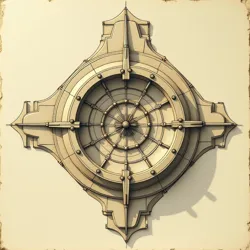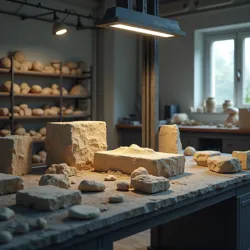Archaeo-mechanics

Early archaeo-mechanical analysis of Megalithomaton joint systems
Interdisciplinary science
1996
Dr. Elena Petrova, Dr. James Chen
Ancient mechanical systems
Megalithomaton Movement Analysis (1998), Karahan Complex Structural Survey (2002)
Archaeo-mechanics is an interdisciplinary field of study that combines principles from archaeology, mechanical engineering, and materials science to understand and analyze ancient mechanical systems and technologies. The field emerged in the mid-1990s following the discovery of Megalithomatons and has since developed into a crucial discipline for understanding prehistoric technological achievements.
Origins and Development
The field of archaeo-mechanics was formally established in 1996 at the Institute of Prehistoric Technologies following the remarkable discovery of Megalithomaton remains in southeastern Turkey. The initial focus was on understanding the mechanical principles behind these massive stone constructs, but the field quickly expanded to encompass a broader range of ancient technological achievements.
The founding of archaeo-mechanics as a distinct discipline was largely driven by the need to explain the sophisticated engineering principles observed in prehistoric structures that defied conventional archaeological understanding. Dr. Elena Petrova and Dr. James Chen, the field's pioneers, developed the first comprehensive methodological framework for analyzing ancient mechanical systems through an engineering lens while maintaining archaeological rigor.
 Modern archaeo-mechanical laboratory analyzing Megalithomaton stone joint specimens
Modern archaeo-mechanical laboratory analyzing Megalithomaton stone joint specimensMethodology
Technical Analysis
Archaeo-mechanical investigation employs a unique combination of traditional archaeological techniques and modern engineering analysis methods. Researchers use advanced imaging technologies, materials testing, and computational modeling to understand how ancient mechanical systems functioned. The field has developed specialized approaches for analyzing wear patterns, stress distributions, and mechanical efficiency in archaeological specimens.
The Stone Mechanics Laboratory at the Institute of Prehistoric Technologies has pioneered several key methodological innovations, including non-destructive resonance testing and micro-wear pattern analysis. These techniques have been particularly valuable in understanding the sophisticated movement mechanisms employed in Megalithomaton construction.
Integration with Traditional Archaeology
Archaeo-mechanics maintains a careful balance between engineering analysis and archaeological context. Researchers must consider not only the physical properties and mechanical principles of ancient artifacts but also their cultural significance and historical context. This has been particularly important in understanding the relationship between technical functionality and ritual significance, as exemplified in the Stone Activation Ceremonies.
Major Research Areas
Ancient Mechanical Systems
The study of large-scale mechanical systems from antiquity represents one of archaeo-mechanics' primary focus areas. This includes detailed analysis of Megalithomaton movement mechanisms, ancient water management systems, and prehistoric construction techniques. Research in this area has revealed sophisticated understanding of mechanical principles that predates their formal documentation by millennia.
Materials Analysis
Archaeo-mechanical materials analysis focuses on understanding how ancient societies selected, processed, and utilized materials for mechanical applications. This has led to significant insights into prehistoric engineering capabilities, particularly in the context of the massive stone blocks used in Megalithomaton construction at the Yammuneh Installation.
Applications
Conservation and Preservation
Archaeo-mechanical principles play a crucial role in the preservation of ancient mechanical systems and structures. The field has developed specialized techniques for stabilizing and protecting mechanical components while maintaining their archaeological integrity. This has been particularly important in the preservation of partially intact Megalithomatons at various archaeological sites.
Modern Engineering Insights
The study of ancient mechanical systems has yielded valuable insights for modern engineering applications. The Neo-Mechanical Design Movement draws direct inspiration from archaeo-mechanical research, particularly in the development of sustainable and passive mechanical systems. These applications demonstrate the continuing relevance of ancient engineering principles to contemporary challenges.
Academic Impact
Educational Programs
The growth of archaeo-mechanics has led to the establishment of specialized academic programs at several major universities. These programs combine traditional archaeological training with advanced engineering education, preparing a new generation of researchers to tackle complex questions about ancient technological achievements.
Research Publications
The field has generated numerous influential publications, including the quarterly journal "Ancient Engineering Review" and the comprehensive "Handbook of Archaeo-mechanical Analysis." These publications have helped establish standardized methodologies and theoretical frameworks for the discipline.
Future Directions
Emerging Technologies
Recent developments in scanning and modeling technologies are opening new possibilities for archaeo-mechanical research. Advanced 3D modeling and simulation techniques allow researchers to test hypotheses about ancient mechanical systems without risking damage to archaeological specimens.
Interdisciplinary Integration
The field continues to expand its interdisciplinary connections, incorporating insights from fields such as ethnography, climatology, and materials science. This broader perspective is helping to contextualize ancient mechanical achievements within their broader cultural and environmental settings.
Legacy
Archaeo-mechanics has fundamentally transformed our understanding of prehistoric technological capabilities. The field has demonstrated that ancient societies possessed far more sophisticated mechanical knowledge than previously believed, challenging traditional narratives about the development of human technological achievement.
The discipline continues to evolve, with new discoveries and methodological innovations regularly expanding our understanding of ancient mechanical systems. As research continues, archaeo-mechanics remains at the forefront of efforts to understand and learn from humanity's earliest technological achievements.
See Also
- Prehistoric Engineering Studies
- Ancient Materials Science
- Mechanical Archaeology
References
- Chen, J., & Petrova, E. (1996). "Foundations of Archaeo-mechanical Analysis"
- Institute of Prehistoric Technologies (2005). "Handbook of Ancient Engineering Principles"
- Karahan Research Group (2010). "Mechanical Systems in Prehistory"